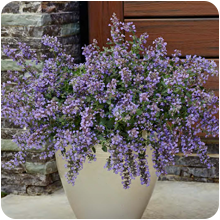‘PAINT THE TOWN’ MAGENTA
DIANTHUS
Grow a Carpet of Color
- Showy, easy care perennial for landscapes
- Covered in fragrant, magenta pink flowers in early summer
- Reblooms intermittently from summer into fall
- Attracts pollinating bees and butterflies
- Blooms best in 6+ hours of sun, tolerates light shade
- 6-8” tall x 12-14” spread
- Reliably perennial in USDA Zones 4-9
- Pronounced “die-AN-this”
If using broad swathes of flashy color is your style, you’ll find that planting ‘Paint the Town Magenta’ is one of the best ways to glam up your garden. You won’t even notice its cool blue foliage when its fragrant, quarter-sized blossoms are in their prime, but you’ll love having that evergreen interest persist through the fall and winter.
The Paint the Town series of Dianthus, commonly called pinks, is unique in that it has proven to have greater heat tolerance than many of its kind. That helps it survive and thrive in warm climates just as well as it does in the North. It’ll return year after year as long as the soil is well-drained. Dianthus doesn’t like wet feet.
Pinks’ flowers make fun little posies so you can enjoy them indoors too. Their wiry stems are deceptively strong, which helps them stand up well in a bud vase, but make sure to bring a pair of sharp scissors with you out into the garden when it’s time to harvest. Displaying them as cut flowers is also one of the best ways to enjoy their distinctive, sweet fragrance.
HOW TO GROW ‘PAINT THE TOWN MAGENTA’ DIANTHUS
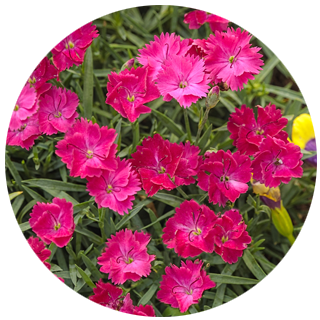
Planting
Look around your landscape to find an open spot where there is abundant sunshine—perhaps along a pathway or in front of taller shrubs in a garden bed. Greater than six hours of sun per day is ideal, especially if most of that sun comes in the afternoon. Sunshine powers this plant to give you the most blooms and robust growth, but it will also survive in as little as four hours of sun.
Dianthus thrives in loose, well-drained soils that aren’t chock full of nutrient-rich ingredients like compost and peat moss. Save those amendments for needier plants. Slightly alkaline to neutral pH soils are preferable, but the only critical requirement is that the soil be well-drained. When its roots sit wet for too long, especially in the winter, they tend to rot, and the plant suffers.
Since ‘Paint the Town Magenta’ Dianthus is evergreen, the best time to plant it is in the spring or early summer so there is plenty of time to establish a good root system before winter arrives. That’s perfect timing since you will most likely find it at your garden center early in the season when it’s in bloom.
If the roots are densely circled around when you take the plant out of the pot, loosen them up a bit to break the “root memory”. This will encourage them to grow outward instead of continuing to grow in a circular pattern. Set the plant in the hole, making sure that the top of the rootball is level with the top of the surrounding soil, then backfill the hole. Press it down with your hand firmly to eliminate any big air pockets around the roots.
Once planted, water the plant to help the soil settle. The first season while it is getting established, it will need a little more water than in subsequent years. Once its roots are anchored in, they will be able to seek the available moisture from the soil, making the plant more self-sufficient.
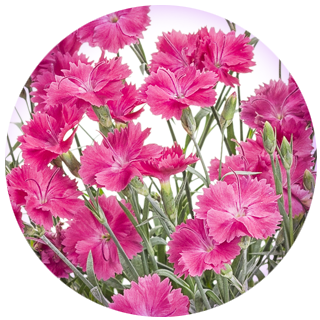
Maintenance
Once you have ‘Paint the Town Magenta’ planted in the right place, little care is needed. This truly is a low maintenance perennial that prefers not to be pampered. It can handle the sun, heat and moderate drought all on its own, though it does appreciate some water when it’s in bloom if you haven’t had much rain.
Expect the first round of blossoms to appear in late spring to early summer, depending on your climate. Rather than removing the spent flowers individually as they turn brown, wait until the whole plant is finished blooming and then shear the spent flower stalks off all at once with a pair of scissors. Doing so encourages the plant to rejuvenate and send up fresh new flower stalks intermittently throughout the summer and fall.
If you’d like to fertilize your Dianthus, do so by scratching some slow release plant food like Espoma’s Plant-tone® into the soil around the roots in early spring. No other fertilizer should be needed.
Deer typically pass this short perennial right on by, but rabbits will make a snack out of its foliage. To prevent damage, it’s a good idea to sprinkle an animal repellent like Plantskydd around it in the spring, summer and fall.
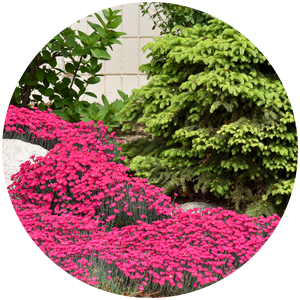
Companion plants
When you are deciding what to plant with your new Dianthus, look first for plants that enjoy similar growing conditions—namely, plants that prefer full sun and well-drained soil.
Since ‘Paint the Town Magenta’ blooms first in late spring or early summer, you could choose to plant it with other perennials that bloom in the same relative timeframe like ‘Cat’s Meow’ catmint, Color Spires® ‘Violet Profusion’ salvia or Decadence® ‘Lemon Meringue’ Baptisia. These pairings would bring a blast of color to your garden in the first half of the growing season.
Later blooming perennials like Pyromania® red hot pokers, ‘Orange You Awesome’ coneflowers and ‘Back in Black’ stonecrop also make good companions for when the Dianthus is out of bloom. Evergreen shrubs like bird’s nest spruce, pictured above, also make a good backdrop for this colorful perennial.
TOP 3 REASONS TO GROW
‘PAINT THE TOWN MAGENTA’ DIANTHUS
SO MUCH COLOR FOR SO LITTLE EFFORT
Even with little care, this perennial will paint your garden in vibrant magenta color for months.
IT TAKES THE HEAT
Gardeners in warm climates will appreciate that the Paint the Town series is designed to handle the heat better than many Dianthus.
FRAGRANT POSIES ABOUND
One can never have enough fragrant flowers in the garden! Since ‘Paint the Town Magenta’ blooms so prolifically, you’ll have plenty spare for cutting.
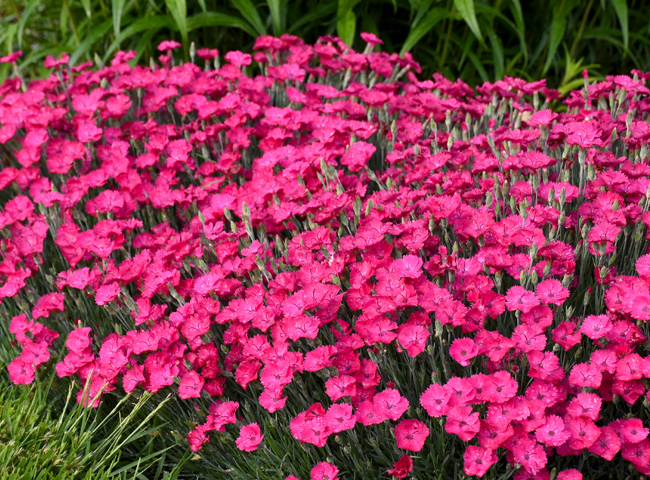
Love the look of ‘Paint the Town Magenta’ Dianthus? Look for it at your local garden center, or Shop Online.
‘Paint the Town Magenta’ Dianthus hybrid USPP29222 CanPBRAF

